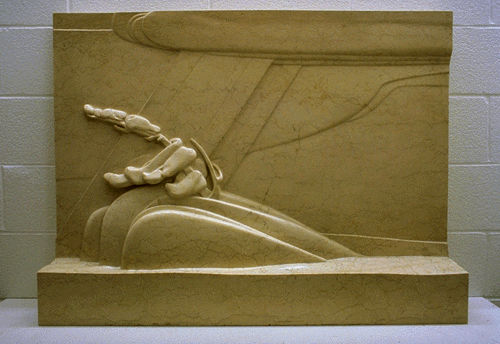Sculptures are a important influence behind the development of the Italian Renaissance and principal form of monumental religious art; for centuries (c.400-1800) been the driving force of European civilization.
The Chinese were master craftsmen; producing fine sculptures (especially in bronze.) During the Zhou dynasty, art was developed to its peak. In the Han Dynasty tombs, there was a variety of clay figures. Other objects produced in bronze were inlaid with silver and gold.
During the Tang Dynasty in China, Buddhist art developed to its peak. Iron replaced bronze in casting figures, and Stone was a preferred medium for religious sculptures.
In 1974, the most magnificent archeological find of the century was uncovered in Xi'an, China; the Terracotta Army was found in the tomb of Qin Shi Huangdi.
Chinese sculptures were brought to Europe by Marco Polo.
Traditional sculptures are formed from a chosen material or built from the inside; and derived from Ancient Greek and Roman sculptures.
 |
| The Terracotta Army http://thumbs.media.smithsonianmag.com//filer/terra-cotta-soldiers-631.jpg__800x600_q85_crop.jpg |
 |
The Thinker by Auguste Rodin
http://i.dailymail.co.uk/i/pix/2013/05/08/article-0-19AC00B7000005DC-789_634x754.jpg |
 |
Linda, c. |
"Sculptural form is not the imitation of natural form any more than poetry is the imitation of natural conversation . . . While a piece of sculpture may contain visual forms with which we are acquainted by daily experience, it is essentially a design worked out by means of the juxtaposition of masses in space, just as poetry is a design wrought by the sounds of words in time."
Elizabeth was a artist born in Orillia, Ontario.
She studied at the Ontario College of Art, specializing in sculpture in her post graduate year. She later studied at the Arts Students League in New York. In 1930, Elizabeth won the Willingdon Arts Award for Sculpture. In 1946, she attended the first general assembly of UNESCO in Paris. In 1928, she became a founding member of the Sculptors' Society of Canada; and was the president of the society in 1933-1935. From 1929-1958, she was a teacher at Central Technical School in Toronto.
Elizabeth is known for landscape sculptures, but also created portraits, figure studies, and monuments in pewter, aluminum bronze, granite, and limestone. She also experimented with a variety of different themes and unconventional materials.
Her contact with the glaciated formations and landscapes of the Georgian Bay and Muskoka during her childhood influenced her work. Elizabeth was also drawn to the art and design of Ancient Egypt.
 |
Passing Rain
Elizabeth Wyn Wood, 1928, marble
|
John Abeling
A Vancouver Island sculptor born in Summerland, Okanogan. He has lived in Campbell River for the past 30 years.
He first began by whittling pieces of wood he would find, increasing the size of the wood and carving/sculpting a work of art. Babe Gunn, mentored John knowing of the natural talent he possessed. Babe Gunn taught him the way of using the medium Stone.
He works with marble he quarries himself. John finds the rain-forest marble in a remote area.
He believes sculpting needs to be from conception, by going to get the stone, seeing the finale product it has become. His art work is based on the environment, the connectivity of the earth and wildlife. His work is displayed at his home studio and at Painters Lodge in Campbell River, B.C.


Steps on How to Make a Paper Mache Sculpture
Materials-Gloves-if needed
Paste/glue
Scissors
Tape/glue to hold the materials together if needed
Wire/cardboard/balloon/ the material you are using to build your frame
News paper/ paper/ paper napkins
A table/surface to work on
Paint-if you want to paint your sculpture
Make sure you cover the surface you work on for a easy clean up
1) Prepare to make your sculpture- Get your frame built. The material used to build the frame must
hold the shape you want to mache.
ex: If I want a dragon shape, I make sure the material can hold that shape for me.
2) Once you get your shape, Prepare your paste/glue in a bowl unneeded bowl and cut your paper into strips. If your using paste, make sure it is NOT thick. Wall paper paste is suggested.
3) Place your paper/napkin in the paste/glue and make sure there is only enough to make the paper/napkin damp. If you use too much paste and you're using a napkin, the napkin will rip and make it more difficult for each strip to be placed onto the sculpture.
4)Place each strip onto the parts of the sculpture you want to cover.
5) When you have covered your sculpture, let the paste dry.
6) Paint your sculpture. This step is optional since some people may not want to paint their sculpture.
There are recipes for how to make the mache paste/glue. There are different videos on Youtube that shows recipes on how to make paper mache paste.
https://www.youtube.com/watch?v=OAOnj3fhxZE
http://www.gallery.ca/en/see/collections/artist.php?iartistid=5981
http://www.johnabeling.com/biography
http://wag.ca/art/collections/canadian-art/display,modern/47831
http://cwahi.concordia.ca/sources/artists/displayArtist.php?ID_artist=58
http://www.thecanadianencyclopedia.ca/en/article/elizabeth-wyn-wood/
No comments:
Post a Comment